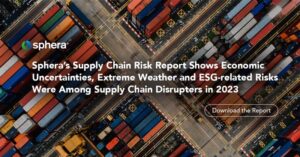
March has been a busy month. It began with the release of the finalized SEC rules for climate-related disclosures on March 6. With confirmation that Scope 1 and Scope 2 emissions disclosures will be required, publicly listed companies should acquire the tools they need for auditable reporting, if they haven’t already.
On March 15, the EU’s Corporate Sustainability Due Diligence Directive (CSDDD) was approved by a majority of EU countries. It is expected to pass a final vote in April. The directive obligates large EU businesses to identify, reduce and eliminate any negative environmental and social impacts that occur in their operations and supply chains. Non-EU businesses with 1,000+ employees that generate at least €450 million in net turnover within the EU are also in scope.
Overall, the CSDDD reinforces the need for robust supply chain risk management. Supply chain managers are well aware of this growing requirement, thanks to the COVID-19 pandemic, the war in Ukraine and the disruptions in the Panama Canal and Red Sea. Extreme weather and climate-related events are increasing in frequency as well, giving supply chain managers additional and often unpredictable elements to monitor. Like supply chains themselves, supply chain risk management is multifaceted and complicated.
The events I referenced are only a few of the developments that have recently impacted supply chains. There have been many others, and they have varied in terms of their causes, consequences and severity. Some risk events have received widespread media coverage, and others have slipped by somewhat undetected—that is, until they forced an interruption in business as usual.
Learning from past events is a good way to prepare for what may lie ahead. And the best place to start is our recent Sphera Supply Chain Risk Report, which covers the economic, geopolitical and weather-related developments that affected supply chains in 2023. The report’s information and analysis will help you identify and address weaknesses in your supply chain, which will ultimately promote business continuity and regulatory compliance.
The report relies on information provided by the Risk Intelligence component of Sphera’s Supply Chain Risk Management (SCRM) software. This AI-powered tool monitors events and developments in real time by scanning more than 15 billion reputable news articles, commercial and government data sources and one million customer and supplier sites around the world on a monthly basis. After filtering out the “noise” of irrelevant or duplicate messages, our Risk Intelligence tool generates notices about everything from an acquisition deal that has implications for the acquired company’s partners to a hurricane forming in the Atlantic to a cyberattack that could lead to data loss. Risk Intelligence captures everything a supply chain manager needs to know and more.
There was quite a lot to monitor in 2023, and the following sections give you a quick look at three events or trends that had an impact on supply chains.
1. Economic trends
Economic trends played a big role last year, with pressure from factors such as site closures or relocations, inflation and increased interest rates causing financial distress among suppliers. Within the category of financial risk, 36% of the notifications issued last year warned of a company’s worsening revenue or growth outlook, possibly indicating trouble for its supply chain partners. Overall, the average manufacturing firm received notices for 58 supplier financial health events last year.
If you partner with a business that finds itself in a tight spot financially, news of its financial struggles may take time to reach you. But it’s information you need if you want to keep your production line moving. Staying informed about general economic trends and developments will help, but the micro-level details are what you really need. Our SCRM software does the work for you.
2. Cyber incidents
Cyber incidents often have a domino effect, impacting entities that are seemingly far removed from the site of the initial attack. Last year brought a 62% increase in cyber-related supply chain issues over 2022. And while these events can include data breaches and theft as well as disruption and compliance problems, they are also very costly: A 2023 IBM survey estimated that a data breach could cost a company as much as $4.45 million.
An organization may go to great lengths to protect its own IT and data infrastructure, but it’s risky for that company to assume that its suppliers do the same. Companies that connect to suppliers through bidding portals may be vulnerable if a supplier’s cybersecurity is poor. The Impact Analyzer component of our SCRM solution can help businesses by assessing the criticality of their suppliers and identifying vulnerabilities that could translate into a significant risk event.
3. ESG-related risks
ESG-related risks are on the rise, especially in light of new regulations such as the CSDDD, the German Supply Chain Due Diligence Act and Canada’s supply chain act. Investors and consumers are another source of pressure: Investors want to limit their risk exposure, and consumers expect companies to operate ethically and sustainably.
Environmental, social and governance considerations are front and center, whether you’re looking at a business’ operations or its supply chain. A violation or compromise in any of these areas can lead to fines or penalties for noncompliance, as well as reputational damage. Despite the heightened focus on these areas, our report notes that human rights notifications rose by 12% in 2023 and notifications of labor practice issues went up by 13%. Companies must be able to quickly detect and address these problems in their supply chains to avoid any negative consequences.
These are just three of the risk areas that presented problems for supply chains last year. Our Risk Report provides a look at other problem areas, as well as the Sphera supply chain solutions that enable companies to mitigate supply chain risk and build a more resilient supply chain. Don’t hesitate to get in touch if you’d like more information about these solutions or supply chain risk in general. With the right expertise and a customized supply chain risk management solution, you can withstand supply chain challenges for years to come while helping to create a safer, more sustainable and productive world.
–Paul
Learn more about Paul Marushka.
Navigating supply chains in an ESG world


